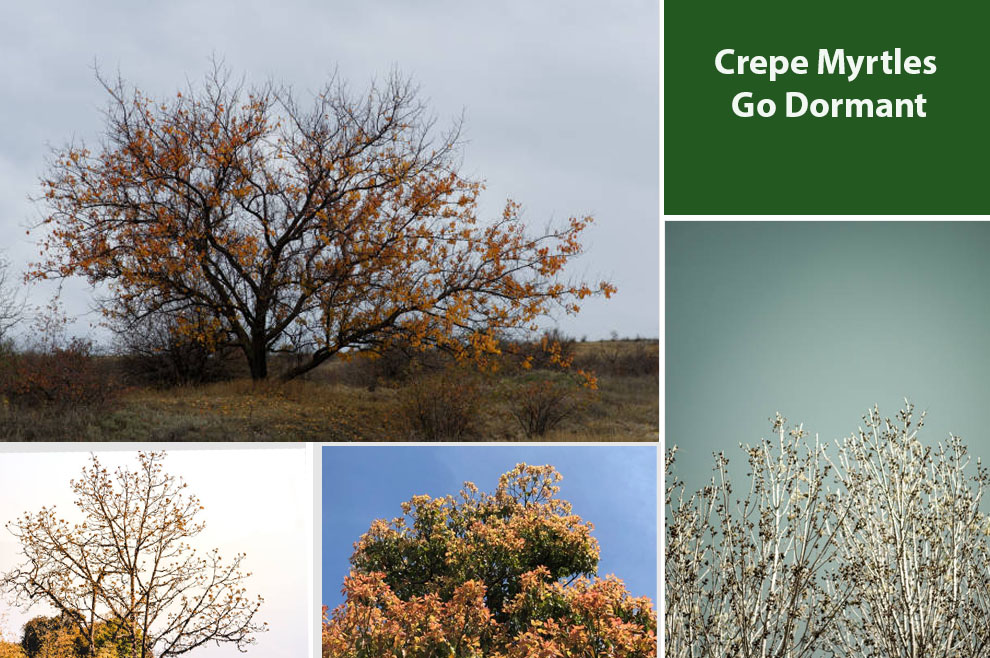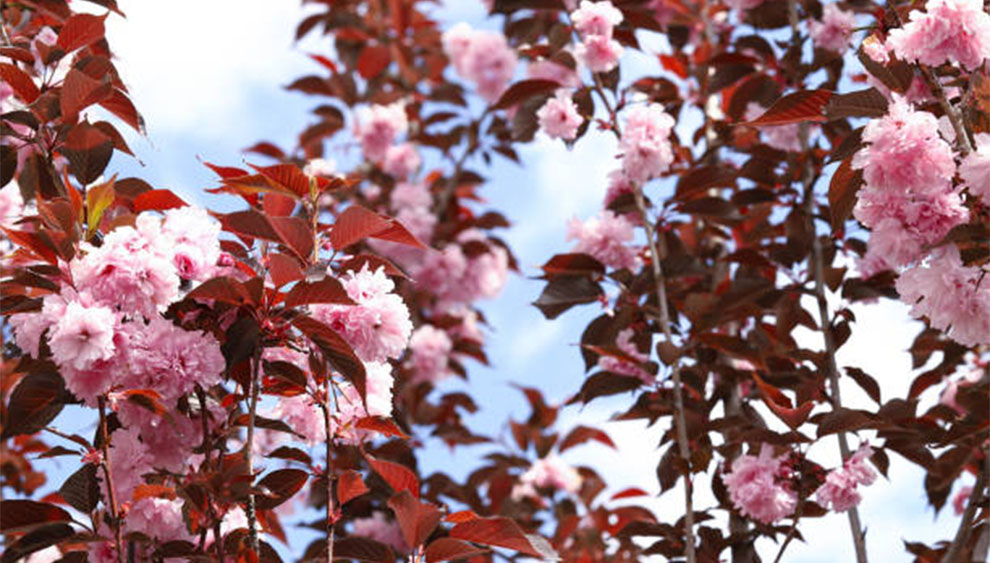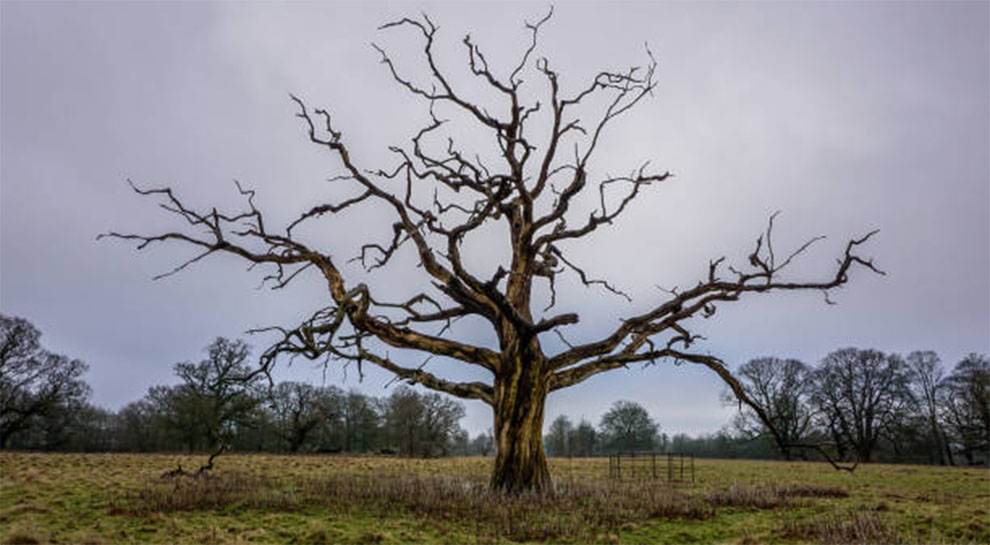When Do Crepe Myrtles Go Dormant?
From winters till spring, it is time for crepe myrtles to rest and rejuvenate…

We all know what a Crepe Myrtle looks like when it is in full bloom. It is prevalent across the mid-spring to late summer months. But they look entirely different when they enter fall and winter. They change the colors of their lush green leaves to yellow, red, and orange shades in fall.
But, do crepe myrtles go dormant in winter?
As a matter of fact they do. The tree loses all its leaves and enters dormancy in the winter months. It is when you will see the tree’s exfoliating bark. We will discuss this in detail and how dormancy differs from a dead crepe myrtle.
So, continue reading to find out all about crepe myrtle dormancy.
When Do Crepe Myrtles Go Dormant and What Care Do They Need Then?

Crepe myrtle is a beautiful, deciduous plant. Studies from Missouri Botanical Garden reveal that in the fall, its leaves change color to red, orange, and yellow and enter dormancy during winter.
During this time, the plant consumes minimal water via its roots, and you will see new signs of life only a few weeks later when the dormant or inactive buds start swelling. Finally, the shrubs begin extracting water from the soil.
You must keep the crepe myrtles’ roots warm in this period. Mulching the area can be beneficial, but do not mulch till the plant enters dormancy or is leafless in the early winter or fall, as that puts the plant at risk of cold injury when winter arrives.
You can add three or four inches of shredded bark or straw on the ground underneath the plant’s canopy and mulch back from the base to avoid moisture build-up.
So, now, you have an answer on crepe myrtle’s dormancy and even ways to shield your plant during this time. But please remember to remove the mulch to avoid overwintering insects and their eggs. You can then replace it with a fresh mulching layer to help the soil conserve moisture for the following season.
When the buds start swelling in spring, water the crepe myrtle regularly. It can be a good start for the plants. However, do not overwater. An inch of water every week, including rain, will suffice.
Do Crepe Myrtles Go Dormant In Winter Every Year?
During fall, much of the landscape undergoes a severe change, and you will see a switch from the bees humming around the summer blooms to a cascade of colors, and your crepe myrtle is no exception. Hence, as the summer months settle down, the Crepe Myrtle enters into an energy conservation mode and slowdown in its processes. It also stops blooming.
Depending on your crepe myrtle’s variety, some leaves will change color, making them seem more lively. Over time, the colors start fading, and the weather cools down. So, you will see the Crepe Myrtles entering the state of dormancy, and the process is the same every year.
Towards the end of fall, the Crepe Myrtle starts losing its leaves, but they do not shed all the leaves until winter. Hence, when the plant loses leaves during early fall or summer, it is a giveaway sign of trouble, such as pest activity or fungal disease. Therefore, take immediate measures to overcome it.
On the flip side, if you live in a warmer zone dormancy timing is different. The Crepe Myrtle may hold on to its leaves for longer than expected. If that happens, do not make the blunder of plucking the leaves by hand. You can let nature run its course, and eventually, in its time, the leaves will blow off and die.
At times, the tree also develops abscission cells that start pushing the dead leaves and shut the opening where leaves were once annexed. You can use this as an opportunity to prune your dead foliage.
Is My Crepe Myrtle Dead or Dormant – How to Identify A Dead Crepe Myrtle?

You know when do crepe myrtles go dormant, but in case of confusion here are some tips that can help ensure whether your plant is dead or just dormant (alive):
- Anytime you feel your Crepe Myrtle appears dead, do not get worked up immediately, and take it slow. So, start by scratching the bark using a knife at the plant’s top. Upon doing so, if you see green flesh underneath the bark, it indicates that your plant is alive and dormant.
- If the bark is brown, it again does not necessarily imply that your plant is dead. So, you begin at the top and cut your plant back down the plant till the green flesh finally appears. Once done, check if the plant pushes new growth in the coming months. If not, the plant may have completed its lifespan.
The Blooming Season for Crepe Myrtle
The blooming time for crepe myrtle varies on different factors, such as the chosen cultivar, planting zone, and the conditions you expose the plant to. So, if your crepe myrtle starts to bud and leaf in the spring, blooming will happen in summer.
The plant thrives in a warm climate, provided it receives ample sunlight. Consequently, hardiness zones further north tend to take longer to bloom. But, in the coldest zone where you may find crepe myrtle, USDA zone 6, the plant does not bloom until late July or early August. On the contrary, in USDA zone nine, the buds typically appear until late March, and blooms show in end-May or early June.
As a general rule of thumb, you can see leaves only a month after the last frost and two months after for the flowers to show.

Let us understand this with an example:
You live in USDA Zone Eight. In this environment, the last frost date is March 28th. Consequently, the crepe myrtle will have its buds and leaves by April, and flowering will commence by the end of June (Two months from April). Now, suppose you live in USDA zone seven – You will find the last frost on April 3rd. So, you will see buds and leaves in early May, and flowers will show in early July.
But, in USDA zone ten, wherein frost is uncommon, Crepe Myrtle shows flowers in mid-May, and the blooms remain on the tree for an extended period, at least 100 days. Some people breed varieties for an earlier blooming season, but dead-heading spent flowers with good pruning can prolong the blooming season.
In the end, remember, regardless of where you live (zone), some weather anomalies and micro-climates impact the outcome. So, use these guidelines for your region. Hence, if you know the date of the last frost, you can easily predict the blooming season.
But, if the plant does not bloom or your tree is underperforming, it may be an indication of one of the following crepe myrtle problems:
- You pruned too late or too aggressively.
- There is not much new growth.
- You have been using too much fertilizer.
- Your plants have poorly drained, overwatered soil.
- The plant may be infected by leaf spots, fungus growth, or insect infestation.
Related Read: Crepe Myrtle’s Growth Rate | Crepe Myrtles Lifespan
Frequently Asked Questions
Ques 1. Do crape myrtles re-bloom every year?
Ans. Whether the flowers come back depends on the myrtle care shown in the previous season. The plant develops new growth in spring, resulting in summer flowers. Hence, early spring or late winter fertilization can cause blooming in the summer.
Ques 2. When do crepe myrtles shed their leaves?
Ans. Crepe Myrtle is a deciduous tree. Hence, it loses its leaves in the winter.
Summing Up…
We hope now you know when do crepe myrtles go dormant. The plants undergo this natural process every winter wherein they peel and shed the bark from the trunks, but the Crepe Myrtle is not the only plant that undergoes this snake-like process, but they are the ones that look most appealing doing so.
